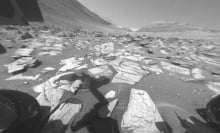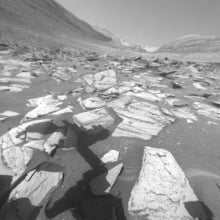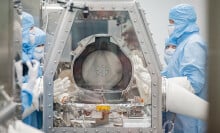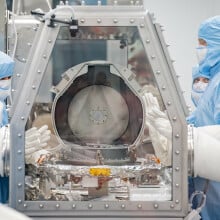Two little screws almost ruined the ending of NASA's seven-year space journey to asteroid Bennu and back.
But after more than three months of trying to pry the lid off a can containing the bulk of rocks and dust from the asteroid, engineers have finally done it. To remove the stuck top, they made and tested new tools that could safely unscrew the fasteners without damaging the precious sample.
So far the science team has only seen grainy cell phone pictures of the sample, said Andrew Ryan, a co-investigator on the NASA mission, but better photos are expected next week.
"We are all delighted by what we’ve seen inside," Ryan told Mashable.
Tweet may have been deleted
NASA's $800 million OSIRIS-Rex mission, short for Origins, Spectral Interpretation, Resource Identification, and Security Regolith Explorer, launched a robotic spacecraft from Cape Canaveral, Florida, in 2016. It completed its 4-billion-mile flight when it dropped from 63,000 miles above Earth onto a patch of isolated Utah desert on Sept. 24, 2023.
OSIRIS-Rex is the first U.S. mission to retrieve a sample of an asteroid and return it to Earth. Not since the Apollo moon rocks, collected between 1969 and 1972, has NASA brought back space souvenirs of this magnitude.
Bennu was selected for the mission because it is chock-full of carbon, meaning it could contain the chemical origins of life. It also has a very remote chance of hitting Earth in the next century. Learning about the asteroid could be helpful in future efforts to deflect it, should that become necessary. Bennu was also considered a convenient asteroid destination because every few years it crosses Earth's orbit around the sun, making it easier to reach than some other asteroids.

Through the OSIRIS-Rex spacecraft, the team saw so-called "hydrothermal mineral deposits" on Bennu they believe may have occurred early in solar system history.
These long veins of salty material could suggest a hydrothermal system similar to what exists at Earth's mid-ocean ridge. It's an intriguing environment where geologists think origin-of-life chemistry may have begun for our own planet. This kind of material hasn't shown up in Japan's Ryugu asteroid sample, which flew back to Earth in 2020, or any meteorites found on Earth.
That's why Jim Garvin, chief scientist at NASA's Goddard Space Flight Center, meant his words literally when he said in September: "This is the rarest stuff we've ever had on Earth."
Scientists paused their efforts to open the sample container in mid-October after they realized two of the 35 fasteners could not be removed with the tools approved for use inside the OSIRIS-Rex glovebox.
To prevent contamination of the sample, NASA's curation team had set stringent rules about what could go inside the glovebox. Only about 15 materials were approved, such as stainless steel, aluminum, and glass. Motors, computers, and circuitry were strictly prohibited.
"This is the rarest stuff we've ever had on Earth."

Immediately after encountering the problem, NASA started making new tools. Two were developed with a specific grade of surgical, non-magnetic stainless steel — the hardest metal approved for use in the pristine curation glovebox.
"These new tools also needed to function within the tightly-confined space of the glovebox, limiting their height, weight, and potential arc movement," said Nicole Lunning, OSIRIS-Rex curator, in a statement. "The curation team showed impressive resilience and did incredible work to get these stubborn fasteners off."
Scientists already swept up some of the dust and rocky bits that leaked into the external container for analysis, almost 2.5 ounces' worth, which exceeded NASA's goal. Portions were shipped off to institutions around the world for studies.
Soon they'll know the total amount of Bennu material they captured by weighing the rest of the contents.
Topics NASA





























